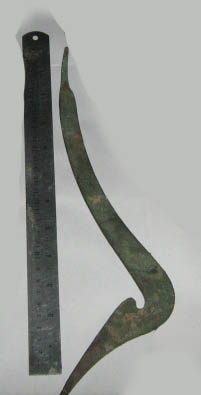Any information would be appreciated.
Thanks





| Peter Johnsson wrote: |
|
EDIT: after a quick googling, here are some ancient images of the Hero Gilgamesh. Both show him using a weapon that is shaped somewhat like a question mark. One is short, the other is much longer. |
| Timo Nieminen wrote: |
|
On the other hand, both weapons are about as long as a lion's body. The long one is definitely long. The lion in the "short" picture isn't small; this is a 4 metre tall Gilgamesh. What else would one expect from somebody who is 2/3 god and 1/3 human? |
| Peter Johnsson wrote: | ||
Even if Gilgamesh is 4 meters tall, his sword would be made in proportion to him, donīt you think? The great Gilgamesh would not be using a puny normal sword of a mere mortal would he? His weapon would be in proportion or overlarge, if anything. |
| Peter Johnsson wrote: |
| This scale and size of the hero aside, the point I wanted to make is that these types of weapons do occur in period art. Or at least something that very much remind of them. |
| Timo Nieminen wrote: |
|
The only candidate I know of in the Epic would be his axe ("Mighty of Heroes"); he only has axe, dagger/sword, and bow. He consistently uses the axe and dagger together, one in each hand (e.g., in the fight against Humbaba, and elsewhere), and usually strikes his opponent with the dagger/sword. But he also cuts down trees with his axe, so it isn't just a mace/club/parrying device. (And the Epic emphasises that it is of suitable heroic weight, 9 score pounds iirc, so not just a puny normal axe.) |
| Dan Howard wrote: | ||
We can't know that without consulting the original text. Does the text use the same word for his weapon and the object he uses to cut trees? |